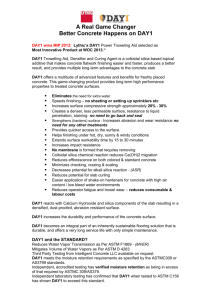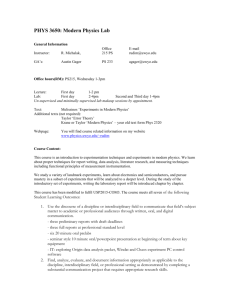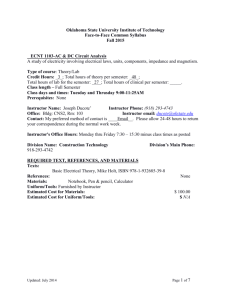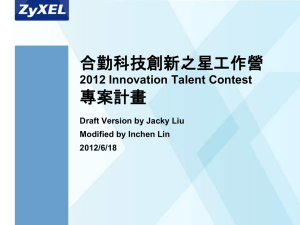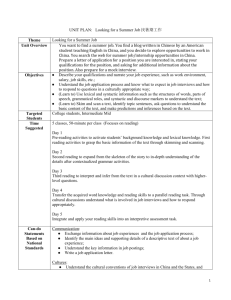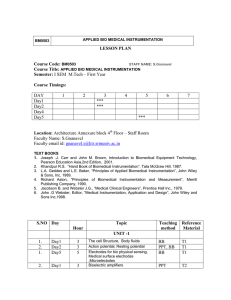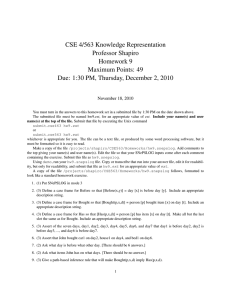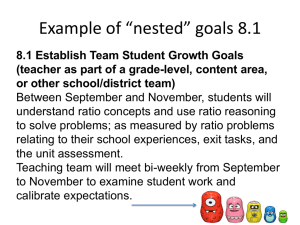AZMerit Vocabulary Activity
advertisement
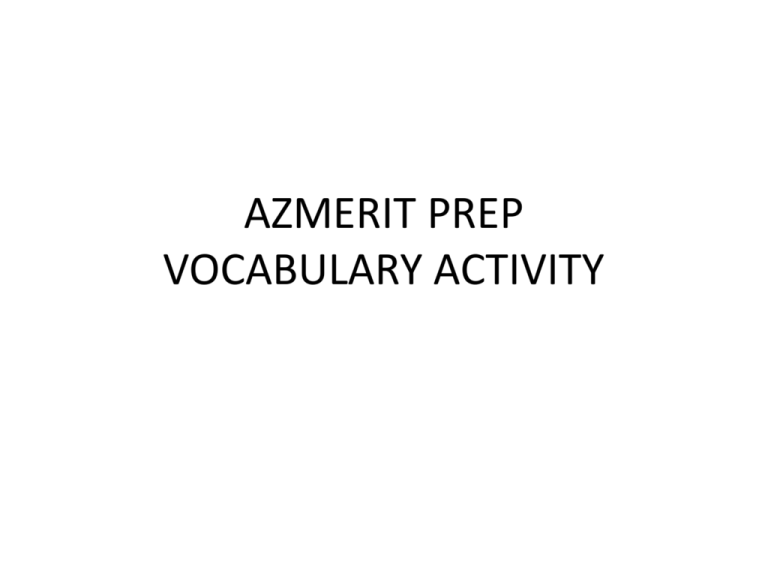
AZMERIT PREP VOCABULARY ACTIVITY Teacher Directions This slide not for display on board. Complete this activity during the 4th hour 15-minute announcement period on 3 days per week for 7 weeks. 1. Write today’s terms and definitions on the board or copy and paste into a Word document and hand out to students each session. See Term Schedule at end of slideshow—Slide 4+. 2. Instruct students to draw two circle maps, one on the front and one on the back of their own paper. 3. Display circle map directions on next slide—Slide 3—and allow students to complete Day 1 information for today’s three terms. Allow students to work in pairs or groups as desired, but each student should have to make their own copy of each map. Students should only spend 3 minutes on each map. Set timer. Goal is not to finish but to spend time discussing and processing the word. 4. While students are completing today’s maps, hand out the previous lesson’s maps. 5. Collect today’s maps after 9 minutes is up. 6. Instruct students to complete the Day 2 information on the previous day’s maps. Students should only spend about 2 minutes per map. Set timer. Goal is not to finish but to spend time discussing and recalling the meaning of the word. 7. Collect completed maps at the bell. Day 2 COPY DEFINITION Day 1 Stop APPLICATION(S) TERM 2 SYNONYMS Day 1 Start ILLUSTRATION 2 ANTONYMS SENTENCE (WORD IN CONTEXT) DEFINITION (IN OWN WORDS) Day 2 WEEK 1 DAY1: Acronym—an abbreviation formed from the initial letters of other words and pronounced as a word (e.g., ASCII, NASA). Adaptation—the action or process of being changed, altered, or modified. DAY 2: Allegory—a story, poem, or picture that can be interpreted to reveal a hidden meaning, typically a moral or political one. Allusion—an expression designed to call something to mind without mentioning it explicitly; an indirect or passing reference. DAY 3: Archetype—a very typical example of a certain person or thing. Assimilation—The process by which a person or persons acquire the social and psychological characteristics of a group. WEEK 2 DAY1: Bias—prejudice in favor of or against one thing, person, or group compared with another, usually in a way considered to be unfair. Catalyst—a substance that increases the rate of a chemical reaction without itself undergoing any permanent chemical change; a person or thing that precipitates an event. DAY 2: Classification—the action or process of putting things into groups according to shared qualities or characteristics. Cohesion—the action or fact of forming a united whole; the sticking together of particles of the same substance. DAY 3: Conservation—the action of preserving, protecting, or restoring something in particular. Consumer—a person who purchases goods and services for personal use. WEEK 3 DAY1: Credibility—the quality of being trusted and believed in; the quality of being convincing or believable. Criteria—a principle or standard by which something may be judged or decided. DAY 2: Deficit—the amount by which something, especially a sum of money, is too small. Denotation—the literal or primary meaning of a word, in contrast to the feelings or ideas that the word suggests. DAY 3: Diversify—make or become more varied. Domain—an area of territory owned or controlled by a ruler or government; a specified sphere of activity or knowledge. WEEK 4 DAY1: Empirical—based on, concerned with, or verifiable by observation or experience rather than theory or pure logic. Hierarchy—a system or organization in which people or groups are ranked one above the other according to status or authority. DAY 2: Hyperbole—exaggerated statements or claims not meant to be taken literally. Hypothesis—a supposition or proposed explanation made on the basis of limited evidence as a starting point for further investigation. DAY 3: Ideology—a system of ideas and ideals, especially one that forms the basis of economic or political theory and policy. Infrastructure—the basic physical and organizational structures and facilities needed for the operation of a society or enterprise. WEEK 5 DAY1: Irony—the expression meaning by using language that normally signifies the opposite (sarcasm); a state of affairs or an event that seems deliberately contrary to what is expected. Laissez-faire—a policy or attitude of letting things take their own course, without interfering. DAY 2: Inference—a conclusion reached on the basis of evidence and reasoning. Momentum—the quantity of motion of a moving body; the impetus gained by a moving object. DAY 3: Omniscient—knowing everything. Parameter—a limit or boundary that defines the scope of a particular process or activity. WEEK 6 DAY1: Postulate—suggest or assume the existence, fact, or truth of something as a basis for reasoning, discussion, or belief. Propaganda—information, especially of a biased or misleading nature, used to promote or publicize a political cause or point of view. DAY 2: Qualitative—relating to, measuring, or measured by the quality of something rather than its quantity. Quantitative—relating to, measuring, or measured by the quantity of something rather than its quality. DAY 3: Reciprocal—given, felt, or done in return. Scarcity—the state of being in short supply; shortage. WEEK 7 DAY1: Sovereignty—supreme power or authority. Stimulus—a thing or event that evokes a specific functional reaction; a spur or incentive. DAY 2: Structural Analysis—examination of the different components or elements that make up an organization or system. Surplus—an amount of something left over when requirements have been met; an excess. DAY 3: Tone—the general character or attitude of a place, piece of writing, situation, etc. Universal Theme—a common controlling idea or central insight that is applicable to the human condition regardless of when or where a person lives or has lived
